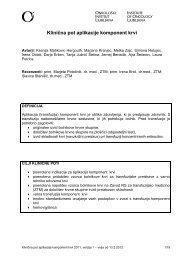Create successful ePaper yourself
Turn your PDF publications into a flip-book with our unique Google optimized e-Paper software.
Increased permeability <strong>of</strong> cell membrane by sonoporation<br />
Alenka Maček Lebar1, Karel Flisar1, Mitja Lenarčič1, Rudi Čop2, Damijan Miklavčič1<br />
1University <strong>of</strong> Ljubljana, Faculty <strong>of</strong> electrical engineering, Tržaška 25, 1000 Ljubljana, Slovenia;<br />
2University <strong>of</strong> Ljubljana, The Faculty <strong>of</strong> Maritime Studies and Transport, Pot pomorščakov 4, 6320<br />
Portorož, Slovenia<br />
A cell membrane separates the interior <strong>of</strong> the cell from its exterior. The function <strong>of</strong> the cell<br />
membrane is to maintain stable cell’s interior by regulating amounts and types <strong>of</strong> molecules<br />
that enter or leave the cell. Sometimes however we need to deliver molecules into the<br />
cell, which otherwise can not pass the membrane. Electroporation (application <strong>of</strong> high<br />
voltage electric pulses) is one <strong>of</strong> the most widely used techniques that allow access to the<br />
cell interior. Electroporation uses high voltage electrical pulses to make the cell membrane<br />
transiently permeable. In the past years, it has been demonstrated that ultrasound could<br />
cause similar effects. This ultrasound-mediated increase in cell membrane permeability<br />
has been termed sonoporation. Sonoporation was initially demonstrated using 20 kHz<br />
sonication.<br />
The main purpose <strong>of</strong> this study was to evaluate if the application <strong>of</strong> megahertz frequency<br />
ultrasound leads to enhanced membrane permeabilization and molecular uptake. We used<br />
a 1-cm diameter planar 1 MHz ultrasound transducer which was leant against the chamber<br />
containing cell suspension. The transducer was driven by a function generator with the<br />
center frequency 1 MHz and power output <strong>of</strong> 10 W, 15 W and 20 W. Cell samples were<br />
exposed to continuous ultrasound for 5, 10, 15 or 20 s. The cells were suspended at a<br />
concentration <strong>of</strong> 1x106 cells/ml in a medium containing a fluorescent marker (Propidium<br />
Iodide).<br />
Cell membrane permeability was increased with increased time <strong>of</strong> cell exposure to<br />
ultrasound.<br />
p27109
















